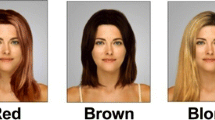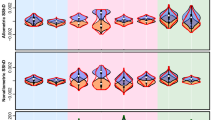Abstract
Although facial features that are considered beautiful have been investigated across cultures using the framework of sexual selection theory, the effects of head hair on esthetic evaluations have rarely been examined from an evolutionary perspective. In the present study the effects of six hair-styles (short, medium-length, long, disheveled, knot [hair bun], unkempt) on female facial attractiveness were examined in four dimensions (femininity, youth, health, sexiness) relative to faces without visible head hair (“basic face”). Three evolutionary hypotheses were tested (covering hypothesis, healthy mate theory, and good genes model); only the good genes model was supported by our data. According to this theory, individuals who can afford the high costs of long hair are those who have good phenotypic and genetic quality. In accordance with this hypothesis, we found that only long and medium-length hair had a significant positive effect on ratings of women’s attractiveness; the other hairstyles did not influence the evaluation of their physical beauty. Furthermore, these two hairstyles caused a much larger change in the dimension of health than in the rest of the dimensions. Finally, male raters considered the longer-haired female subjects’ health status better, especially if the subjects were less attractive women. The possible relationships between facial attractiveness and hair are discussed, and alternative explanations are presented.
Similar content being viewed by others
References
Adachi, K., and H. Uno 1969 Some Metabolic Profiles of Human Hair Follicles. In Advances in the Biology of Skin, Vol. IX: Hair Growth, W. Montagna and R. L. Dobson, eds. Pp. 153–160. Oxford: Pergamon Press.
Alcock, J. 1998 Animal Behavior An Evolutionary Approach. Sinauer Associates.
Baktay-Korsós, G. 1999 The Long-Hair Effect. Review of Psychology 6:37–42.
Bereczkei, T., Sz. Voros, M. Gal, and L. Bernath 1997 Resources, Attractiveness, Family Commitment: Reproductive Decisions in Human Mate Choice. Ethology 103:681–699.
Buss, D. M., and D. P. Schmitt 1993 Sexual Strategies Theory: An Evolutionary Perspective on Human Mating. Psychological Review 100:204–232.
Buunk, B. P., P. Dijkstra, D. T. Kenrick, and A. Warntjes 2001 Age Preferences for Mates as Related to Gender, Own Age, and Involvement Level. Evolution and Human Behavior 22:241–250.
Cunningham, M. R., P. B. Druen, and A. P. Barbee 1997 Angels, Mentors, and Friends: Trade-offs among Evolutionary Variables in Physical Appearance. In Evolutionary Social Psychology, J. A. Simpson and D. T. Kenrick, eds. Pp. 109–140. Mahwah, New Jersey: Lawrence Erlbaum Associates.
Cunningham, M. R., A. R. Roberts, A. P. Barbee, P. B. Druen, and C. H. Wu 1995 The Ideas of Beauty Are, on the Whole, the Same as Ours? Consistency and Variability in the Cross-cultural Perception of Female Physical Attractiveness. Journal of Personality and Social Psychology 68:261–279.
Dawber, R. P., D. de Berker, and F. Wojnarowska 1998 Disorders of Hair. In Textbook of Dermatology, R. H. Champion, J. L. Burton, D. Burns, and Breathnach, eds. Pp. 2869–2913. Oxford: Blackwell Science.
Ebling, F. J., R. Dawber, and A. Rook 1986 The Hair. In Textbook of Dermatology, A. Rook, D. S. Wilkinson, F. J. Ebing, R. H. Champion, and J. L. Burton, eds. Pp. 1937–2037. Oxford: Blackwell Science.
Eibl-Eibesfeldt, I. 1989 Human Ethology. Hawthorne, New York: Aldine de Gruyter, New York.
Fink, B., and I. Penton-Voak 2002 Evolutionary Psychology of Facial Attractiveness. Current Directions in Psychological Science 11:154–158.
Ford, C. S., and F. A. Beach 1951 Pattern of Sexual Behavior. New York: Harper and Row.
Gangestad, S. W. 2000 Human Sexual Selection, Good Genes, and Special Design. In Evolutionary Perspectives on Human Reproductive Behavior, D. LeCroy and P. Moller, eds. Pp. 50–61. Albany: New York Academy of Science.
Gangestad, S. W., and J. A. Simpson 2000 The Evolution of Human Mating: Trade-offs and Strategic Pluralism. Be havioral and Brain Sciences 23:573–644.
Grammer, K., and R. Thornhill 1994 Human (Homo sapiens) Facial Attractiveness and Sexual Selection: The Role of Symmetry and Averageness. Journal of Comparative Psychology 108:233–242.
Grammer, K., B. Fink, A. Juette, G. Ronzal, and R. Thornhill 2001 Female Faces and Bodies: N-dimensional Feature Space and Attractiveness. In Advances in Visual Cognition, Vol. 1: Facial Attractiveness, G. Rhodes and L.A. Zebrowitz, eds. Pp. 91–125. Wesport, Connecticut: Ablex.
Grammer, K., B. Fink, A. P. Moller, and R. Thornhill 2003 Darwinian Aesthetics: Sexual Selection and the Biology of Beauty. Biological Review 78:385–407.
Hinsz, V. B., D. C. Matz, and R. A. Patience 2001 Does Women’s Hair Signal Reproductive Potential? Journal of Experimental Social Psychology 37:166–172.
Hume, D. K., and R. Montgomerie 2001 Facial Attractiveness Signals Different Aspects of “Quality” in Women and Men. Evolution and Human Behavior 22:93–112.
Johnston, V. S., R. Hagel, M. Franklin, B. Fink, and K. Grammer 2001 Male Facial Attractiveness: Evidence for Hormone-Mediated Adaptive Design. Evolution and Human Behavior 22:251–267.
Jones, D. 1995 Sexual Selection, Physical Attractiveness, and Facial Neoteny: Cross-Cultural Evidence and Implications. Current Anthropology 36:723–736.
1996 Physical Attractiveness and the Theory of Sexual Selection. Ann Arbor: University of Michigan Press.
Kalick, S. M., L. A. Zebrowitz, J. H. Langlois, and R. M. Johnson 1998 Does Human Facial Attractiveness Honestly Advertise Health? Longitudinal Data on an Evolutionary Question. Psychological Science 9:8–13.
Kenrick, D. T. and R. C. Keefe 1992 Age Preferences in Mates Reflect Sex Differences in Reproductive Strategies. Behavioral and Brain Sciences 15:75–133.
Kingsley, P. 1995 Hair—An Owner’s Handbook. London: Aurum Press.
Langlois, J. H., L. Kalakanis, A. J. Rubenstein, A. Larson, M. Hallam, and M. Smoot 2000 Maxisms or Beauty? A Meta-analytical and Theoretical Review. Psychological Bulletin 126:390–423.
Miller, G. F. 1998 How Mate Choice Shaped Human Nature: A Review of Sexual Selection and Human Evolution. In Handbook of Evolutionary Psychology. Ideas, Issues, and Applications, C. Crawford and D. L. Krebs, eds. Pp. 87–129. Mahwah, New Jersey: Lawrence Erlbaum.
Muscarella, F., and M. R. Cunningham 1996 The Evolutionary Significance and Social Perception of Male Pattern Baldness and Facial Hair. Ethology and Sociobiology 1996:99–117.
Morris, D. 1985 Bodywatching: A Field Guide to the Human Species. London: Jonathan Cape.
Pelfini, C., D. Cerimele, and G. Pisaru 1969 Aging of the Skin and Hair Growth in Man. In Advances in the Biology of Skin, Vol. IX: Hair Growth, W. Montagna and R. L. Dobson, eds. Pp. 511–534. Oxford: Pergamon Press.
Penton-Voak, I. S., and D. Perrett 2000 Female Preference for Male Faces Changes Cyclically: Further Evidence. Evolution and Human Behavior 21:39–48.
Perrett, D. I., K. A. May, and S. Yoshikawa 1994 Facial Shape and Judgments of Female Attractiveness. Nature 368:239–242.
Perrett, D. J., K. J. Lee, I. Penton-Voak, D. Rowland, S. Yoshikawa, D. M. Burt, S. P. Henzi, D. Castles, and S. Akamatsu 1998 Effects of Sexual Dimorphism on Facial Attractiveness. Nature 394:884–887.
Shackelford, T. K., and R. J. Larsen 1999 Facial Attractiveness and Physical Health. Evolution and Human Behavior 20:71–76.
Symons, D. 1979 The Evolution of Human Sexuality. New York: Oxford University Press.
Thornhill, R., and S. W. Gangestad 1993 Human Facial Beauty: Averageness, Symmetry and Parasite Resistance. Human Nature 4:237–270.
1999 Facial Attractiveness. Trends in Cognitive Sciences 3:452–460.
Thornhill, R., and K. Grammer 1999 The Body and Face of Woman: One Ornament That Signals Quality? Evolution and Human Behavior 20:105–120.
Author information
Authors and Affiliations
Corresponding author
Additional information
Norbert Mesko is a Ph.D. student in the Institute of Behavioral Sciences at the University of Pécs. His main research interests are in mate choice and physical attractiveness.
Tamas Bereczkei is a professor of psychology at the University of Pécs. His research interests span life history strategies, mate choice, parental biases, and reproductive behavior of Gypsies.
Rights and permissions
About this article
Cite this article
Mesko, N., Bereczkei, T. Hairstyle as an adaptive means of displaying phenotypic quality. Hum Nat 15, 251–270 (2004). https://doi.org/10.1007/s12110-004-1008-6
Received:
Revised:
Issue Date:
DOI: https://doi.org/10.1007/s12110-004-1008-6




